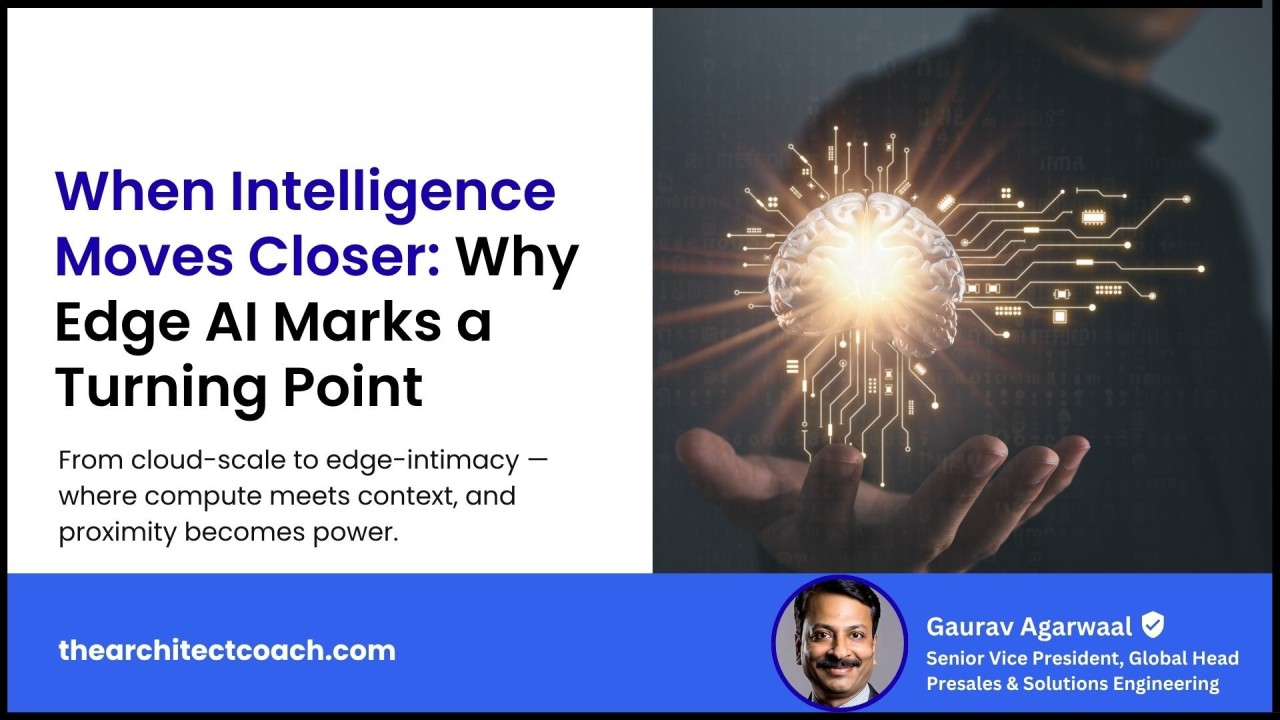A few weeks ago, in a leadership discussion, someone said — “AI is powerful, but it feels distant — I don’t feel it working for me.”
That line stayed with me.
For years, AI has lived in the cloud — abstract, remote, and invisible. But the next era of AI is about proximity. Intelligence is moving closer — into our phones, vehicles, factories, and homes.
And this change isn’t cosmetic. It’s a re-architecture of how intelligence lives, learns, and acts.
The Quiet Revolution : Edge AI – From Cloud to Edge
Edge AI represents a shift in how intelligence is delivered, consumed, and trusted. As machine learning moves from remote clouds into the very fabric of our devices, industries, and homes, it sets off a new wave of value creation defined by proximity, autonomy, privacy, and resilient architecture.
We’ve celebrated billion-parameter models and hyperscale compute, but real disruption is happening where compute meets context.
Edge AI means:
Instant decisions — Reduced decision latency from seconds to milliseconds, critical for applications such as autonomous vehicles, retail checkout, precision manufacturing, and real-time medical diagnostics.
Data sovereignty — insights travel, data doesn’t. Embeds privacy and compliance by keeping sensitive data local, unlocking deployments in healthcare, finance, defense, and any regulated, high-stakes environment
Power efficiency— NPUs from leading vendors now achieve 10–18 TOPS (trillions of operations per second) at top-level energy efficiency—crucial for mobile, embedded, and battery-powered scenarios.
Offline continuity — Delivers sustained intelligence, even when disconnected, enabling continuity in critical infrastructure and remote operations.
Think of it as an AI that lives with you, not away from you.
The Proof Is in the Momentum
The data tells its own story:
Edge AI market → from $27 B (2024) to $270 B (2032)(>33% CAGR).
Edge AI accelerators → $7.7 B → $114 B by 2034(~31% CAGR).
Healthcare already contributes 43% of Edge AI revenue through critical, latency-sensitive applications.
When an industry scales 10× in under a decade, it’s not a trend — it’s an inflection point.

Hardware Is the Unsung Hero
What’s enabling this revolution isn’t just better algorithms — it’s the rise of on-device intelligence.
BrainChip Akida — neuromorphic design offering edge-grade AI with brain-like efficiency.
NVIDIA Jetson Orin NX — 100 TOPS in palm-sized modules powering next-gen robotics.
Snapdragon X Elite NPUs — desktop-class inference on mobile silicon, delivering performance and longer battery life.
Innatera Pulsar — spiking neural chip that mimics cognitive processing at ultra-low power.



These aren’t lab curiosities — they’re the foundation for a future where every device is intelligent by default.
The Software Layer: Local AI Gets Real
Alongside the hardware revolution, the edge ecosystem is exploding:
Nexa AI— local execution of text, vision, and audio models; compression that’s 4× smaller and 3× faster.
Intel OpenVINO & ONNX Runtime— industrial-grade frameworks optimizing inference on ARM and Qualcomm.
Microsoft ONNX & Azure Percept — enabling edge-native AI from model training to on-device inference, powered by the Azure ecosystem.
OpenAI Edge Stack (in preview)— extending small, fine-tuned models to run securely on local devices, bridging cloud intelligence with real-time autonomy.
Google Gemma 3n — multimodal model running fully offline on devices with ≤2 GB RA
Llama.cpp & Ollama— bringing open models to every laptop.
AWS Greengrass — hybrid orchestration combining local autonomy with cloud continuity.

The ecosystem no longer asks “Can AI run locally?” — it’s already doing it, at scale.
The Leadership View: What This Means Strategically
For leaders, this isn’t a hardware story — it’s a strategic reset.
1. Rebalanced Cloud Economics Cloud remains the control plane, but intelligence execution is migrating to the edge — reducing bandwidth costs and increasing autonomy.
2.Resilience as Design Principle Edge-based AI keeps systems operational in disconnected or regulated environments — crucial for healthcare, manufacturing, and defense.
3.Trust as Competitive Advantage By design, data doesn’t move. That’s privacy, compliance, and confidence built into architecture.
4.Smarter, Smaller Models Compression, quantization, and neural efficiency mean compact models can rival giga-scale ones — the next productivity curve is efficiency, not excess.

My Take
Edge AI represents more than technical evolution — it’s a rebalancing of power. From cloud providers owning intelligence to individuals and enterprises owning their own AI experience.
For me, it signals a return to something profoundly human: Intelligence that’s present, adaptive, and trustworthy — close enough to be felt.
The companies that will lead this decade won’t chase size. They’ll design for proximity, privacy, and purpose.
Reflection
When intelligence starts living beside us instead of above us, how will that reshape trust, autonomy, and the very definition of “smart”?
Views: 5.5K


Your writing has a way of resonating with me on a deep level. I appreciate the honesty and authenticity you bring to every post. Thank you for sharing your journey with us.
Nice Article
Nice Article. Well Articulated
Nice Read!
Nice-Article